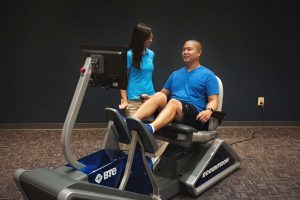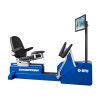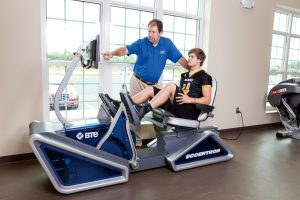
Beyond the Basics: Eccentrics' Versatility in Rehab
Clinical ResearchLet’s take a look at some of these populations, and the outcomes leading researchers have reported from eccentric training. Studies include hip fracture, ACL rehabilitation, TKA, spinal cord injury, Parkinson's and falls.
In today’s clinical environment, practitioners need efficient and effective treatment techniques for patients. Clinics are under pressure to deliver better results, faster – safely, and consistently. In response, clinicians are increasingly turning to new ways to achieve better outcomes. eccentrics
We know that eccentric muscle contractions are unique in their potential for high muscle-force production at a low energy cost. So, it’s not a surprise that eccentric-only strengthening has become a favorite modality among therapists. Many studies have documented the benefits of eccentric muscle exercise. These include strength gains, muscle growth, increased resting energy expenditure, and alterations in neuromotor control that result in changes in physical function.
Eccentric strengthening is flexible enough to treat virtually all patient groups: youth to older adults, sedentary to professional athletes, healthy to those suffering from different conditions and diagnoses. Let’s take a look at some of these populations, and the outcomes leading researchers have reported from eccentric training.
Eccentrics for Post Hip Fracture
Community-dwelling older adults recovering from hip fracture participated in an “extended high-intensity training program” three times per week for 12 weeks following discharge from usual-care physical therapy. In addition to exercise, protein supplementation was provided. The purpose of this study was to evaluate subsequent changes in surgical limb function, whole-body balance, and client confidence. Results included statistically significant increases in quadriceps muscle mass and improvement in quad strength, 6 Minute Walk (6MW), Timed Up and Go (TUG), Stair Climb Test (SCT) and Stair Descent Test (SDT), five times Sit Stand (5xSTS), 14-item Berg Balance Scale (BBS), 29-item Lower Extremity Measure (LEM), and 16-item Activities-Specific Balance Confidence Scale.
Briggs RA, Houck JR, Drummond MJ, et al. Muscle quality improves with extended high intensity resistance training after hip fracture. J Frailty Aging. 2018;7:51-56
Eccentrics for ACL Rehabilitation
Individuals post-ACL reconstruction participated in an “early progressive eccentric exercise program,” two to three days per week for 12 weeks. The purpose of the study was to evaluate the effects of early progressive eccentric exercise on muscle volume and function at one year after ACL-R. Results included statistically significant increases in quadriceps, hamstring, and gluteus maximus muscle volume and improvement in muscle strength, hop-for-distance test, Activities of Daily Living Scale of the Knee Outcome Survey, Lysholm Knee Rating Scale, and Tegner Activity Scale.
Gerber JP, Marcus RL, Dibble LE, et al. Effects of early progressive eccentric exercise on muscle size and function after anterior cruciate ligament reconstruction: a 1-year follow-up study of a randomized clinical trial. Phys Ther J. 2009;89:51-59
Eccentrics for Total Knee Arthroplasty (TKA)
Individuals post-total knee arthroplasty (TKA) reconstruction participated in an “eccentrically-biased rehabilitation program” two times per week for six weeks. This study examined the efficacy of this program initiated one month following TKA surgery. Results included statistically significant improvements in work output, the Physical Components Summary of the Short-From-36 (SF36PCS), 6MW, Lower Extremity Function Scale (LEFS) , SCT, and Gait Speed (GS) assessment and increases in StrengthMVIC and PowerMVPO.
Marcus RL, Yoshida Y, Meier W, et al. An eccentrically biased rehabilitation program early after TKA surgery. Arthritis. 2011, Article ID 353149. Doi:10.1155/2011/353149
Eccentrics Spinal Cord Injury (iSCI)
Individuals with incomplete spinal cord injury (iSCI) participated in an “eccentric resistance training program” two times per week for 12 weeks. The purpose of the study was to determine the effect of eccentric resistance training (ERT) on walking speed, mobility, independence, and at home function following iSCI. Results included statistically significant improvements in TUG (mobility) performance, 10MWT (speed), and Walking Index for SCI (independence).
Stone WJ, Stevens SL, Fuller DK, et al. Ambulation and physical function after eccentric resistance training in adults with incomplete spinal cord injury: a feasibility study. J Spinal Cord Med. 2018. DOI: 10.1080/10790268.2017.1417804
Eccentrics for Cerebrovascular Accident (CVA)
Individuals post-cerebrovascular accident (CVA) participated in a” virtual-reality-based eccentric training program” five times per week for eight weeks. They were divided into slow or fast velocity groups. The purpose of the study was to examine the effect of the program on lower extremity muscle activity and balance. Results indicated that the slow velocity group showed statistically significant differences on LOS (limits of stability) and gastrocnemius muscle activation and vastus lateralis and medialis muscle activation as compared to fast velocity group.
Park SK, Yang DJ, Uhm YH, et al. The effect of virtual reality-based eccentric training on lower extremity muscle activation and balance in stroke patients. J Phys Ther Sci. 2016;28:2055-2058.
Eccentrics for Parkinson’s Treatment
Individuals with Parkinson’s Disease participated in a “high-intensity eccentric resistance training program” three times per week for 12 weeks. The purpose of the study was to examine changes in quadriceps muscle volume, muscle force production, and mobility. Results included statistically significant increases in quadriceps muscle volume and improvements in strength, 6MW, SCT and SDT.
Dibble LE, Hale TF, Marcus RL, et al. High-intensity resistance training amplifies muscle hypertrophy and functional gains in persons with Parkinson’s Disease. Movement Disorders. 2006;21:1444-1452
Eccentrics for Fall Risks
Community-dwelling older adults reporting no history of falling participated in an eccentric training program two times per week for eight weeks. The purpose of the study was to determine changes in balance and strength. Statistically significant improvement in work output, 30-second repeated chair stand test, TUG, and maximum eccentric strength were reported.
Johnson SL, Fuller DK, Donnelly B et al. Effect of an 8-week eccentric training program on strength and balance in older adults. Intl J Exerc Sci. 2018;11:468-478
How About My Patients?
These studies on eccentrics all have one thing in common – the BTE Eccentron. Research shows that incorporating a functional eccentric training program with Eccentron yields improvements in muscle performance and physical/functional performance measures.
As therapists, we see many clients whose treatment goals include improvement of muscle size and strength, various aspects of physical function, and overall quality of life. So it’s significant that functional eccentric training with Eccentron has repeatedly been shown to be a safe and effective means to achieve those goals in a high percentage of our caseloads. It is ideal for safely and effectively rehabilitating a broad range of deficiencies, including neurologic, orthopedic, and functional.
To explore eccentric technology, and learn more about what it can do for your patient population, check out the Eccentron.




